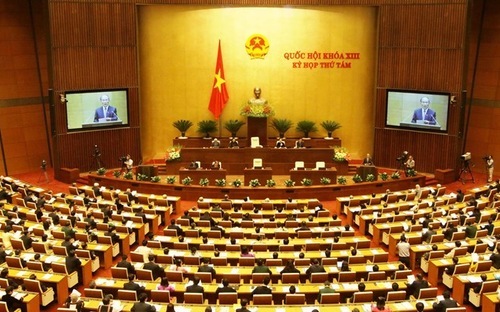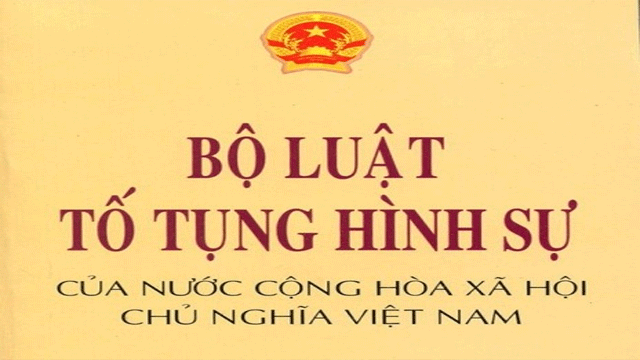The Law on Enforcement of Criminal Judgments 2010, effective from July 1, 2011, is a unified legal foundation that facilitates authorities in executing criminal judgments, including the Courts in Vietnam.
Over more than 06 years of enforcing the Law on the Enforcement of Criminal Judgments, the enforcement of criminal judgments in general and the consideration for reduction in the period of serving the prison sentence, in particular, have become routine, unified, and effective in practical application. However, from the practical application of the law regarding the judiciary's authority in the enforcement of criminal judgments, especially concerning the task of reviewing sentence reduction following Joint Circular No. 02/2013/TTLT- BCA- BQP – TANDTC – VKSNDTC dated May 15, 2013, issued by the Ministry of Public Security, the Ministry of National Defense, the Supreme People’s Court, and the Supreme People’s Procuracy of Vietnam “guiding the implementation of regulations on sentence reduction for convicts,” there are still difficulties, obstacles, and inadequacies that need to be promptly perfected, amended, and supplemented more concretely to enhance the effectiveness of this task, contributing to better protection of human rights in the enforcement of criminal judgments.
Particularly, the Criminal Procedure Code 2015 and the Criminal Code 2015 (amended and supplemented in 2017), which have been in effect since January 1, 2018, present many new issues that need consistent understanding and application in this work. Therefore, it is extremely necessary to promptly amend and supplement Circular No. 02/2013/TTLT- BCA- BQP – TANDTC – VKSNDTC dated May 15, 2013. This aims to unify the application and enhance the effectiveness of its application, contributing to the protection of justice and human rights, and providing motivation for convicts to reform while serving their sentences at detention centers and prisons.
From the practical review of sentence reductions over the past years, we note the following inadequacies:
First, the assessment of dossiers: According to the guidance in Circular No. 02/2013/TTLT- BCA- BQP- TANDTC- VKSNDTC dated May 15, 2013, in Article 12, the compilation of the list of proposed sentence reductions (stipulated 20 days before each session), however, in Article 13, the assessment of dossiers, and the list of proposed sentence reductions lacks a time-limit specification. This leads to the following inadequacies:
Firstly, the Circular does not specify the time frame for each phase, especially the phase for dossier assessment, where the list of proposed sentence reductions is sent from the detention center to the Assessment Council of the Criminal Judgment Enforcement Management Agency under the Ministry of Public Security and the Ministry of National Defense. The Assessment Council evaluates the dossiers and the list, and then reports the results to the Head of the Criminal Judgment Enforcement Management Agency under the Ministry of Public Security and the Ministry of National Defense for approval. There is no specified maximum period for the Assessment Council to provide an official opinion so that the detention center can complete the dossiers, list, and submit the proposal promptly.
Secondly, after receiving the Assessment Council's opinion, the detention center must complete the dossiers and submit them to the court at least a certain number of days before each assessment session. Circular No. 02 lacks specific provisions for this duration to ensure that the Assessment Council has sufficient time to review the dossiers and make decisions, as stipulated in Clause 1, Article 5 of the Circular and Clause 3, Article 33 of the Law on the Enforcement of Criminal Judgments (it should stipulate that the detention center submit the completed dossiers, list, and proposal letter to the court at least 20 days before each session for the court to have time to review, consider, and decide).
Thirdly, the Circular should stipulate that the Assessment Council for sentence reductions at the detention centers should have the right to uphold the proposals of the detention centers regarding the reduction level, beyond what the Council of the Criminal Judgment Enforcement Management Agency proposes, because the Assessment Council at the detention centers understands the rehabilitation process of the convicts better than anyone else. This would provide the Assessment Council of the court with an objective basis to decide on each specific case. Therefore, we propose that the detention center's documents requesting sentence reductions (in cases where there are discrepancies in the reduction levels between the detention centers and the Criminal Judgment Enforcement Management Agency) clearly articulate these viewpoints.
Second, the authority of the Consideration Council for Sentence Reduction
According to Clause 3, Article 15 of Joint Circular No. 02/2013/TTLT- BCA- BQP – TANDTC – VKSNDTC dated May 15, 2013, issued by the Ministry of Public Security, the Ministry of National Defense, the Supreme People’s Court, and the Supreme People’s Procuracy of Vietnam, the Council decides as follows based on the dossier review and the opinion of the Procuracy:
a) Reject the proposed sentence reduction;
b) Accept in full or in part the proposed sentence reduction.
The Council shall not decide a reduction greater than the proposal of the detention center belonging to the Ministry of Public Security, the Ministry of National Defense, the military regions, or the provincial or regional criminal judgment enforcement agencies;
c) For convicts proposed for sentence reduction, if by the time the Consideration Council for Sentence Reduction convenes, the remaining prison term is no more than one month, the Council may decide to reduce the remaining prison term entirely.
Such regulations permit the Council to accept full, partial, or reject the proposed reduction level by the detention centers. However, even when there are grounds to increase the reduction level, the Sentence Reduction Council lacks the authority to decide on a higher reduction level than proposed by the detention centers. In practice, there are convicts with the same sentence, assessed as having good compliance with the judgment and fulfilling civil obligations, yet some proposals are higher than others. Thus, the Consideration Council for Sentence Reduction could adjust this inadequacy, but they are not allowed (surpassing authority), creating injustice and not encouraging convicts to reform adequately. Therefore, we propose amending item 2, Clause 3, Article 15 of Joint Circular No. 02/2013/TTLT- BCA- BQP – TANDTC – VKSNDTC dated May 15, 2013, as follows: replace the content "not allowed to decide on a reduction higher than..." with "may decide on a reduction higher than the proposed level... if there is sufficient basis." This would ensure objectivity, fairness, and encouragement for convicts to strive for progress.
Secondly, for item c, Clause 3, Article 15: "For convicts proposed for sentence reduction, if by the time the Consideration Council for Sentence Reduction convenes, the remaining prison term is no more than one month, the Council may decide to reduce the entire remaining prison term." We find this guidance lacks proximity. As stated in point d, Clause 1, Article 2 of Resolution No. 02/2007/NQ-HĐTP dated October 2, 2007, of the Judicial Council of the Supreme People's Court, “For persons proposed for sentence reduction, after the full acceptance of the proposed reduction term, if the remaining term of the sentence is no more than 1 month, the Sentence Reduction Council may decide to reduce the entire remaining term.” Thus, we propose amending item c, Clause 3, Article 15 of Circular No. 02 to align with point d, Clause 1, Article 2 of Resolution No. 02/2007/NQ-HĐTP dated October 2, 2007, of the Judicial Council of the Supreme People’s Court to be more consistent and practical.
Thirdly, item 1, Clause 3, Article 7 of Joint Circular No. 02/2013/TTLT- BCA- BQP – TANDTC – VKSNDTC dated May 15, 2013, by the Ministry of Public Security, the Ministry of National Defense, the Supreme People’s Court, and the Supreme People’s Procuracy of Vietnam stipulates, “Each year, a convict is considered for sentence reduction once, the interval between two reductions must be at least one year. If the remaining prison term is less than one year after the reduction, the convict may be considered for an early reduction in the following year, but still only once per year.” Practical application shows different viewpoints among judicial agencies. One opinion argues that the reduction point timing should be calculated from the period the reduction proposal dossier was compiled at the detention center. Another opinion asserts that the calculation should start from the nearest prior reduction period. For example, if a convict A was granted a sentence reduction on December 22, 2016, and if the remaining prison term from December 22, 2016, is under 12 months, the following year, 2017, the convict can continue to be proposed for an early reduction in the specific period like September 2, 2017. We believe the second viewpoint is accurate. Specifically, the calculation should start from the nearest reduction period; if by then, after the reduction, the remaining prison term is less than 12 months, the following year, an early reduction proposal can be made. If it is 12 months or more, the usual sentence term applies. Therefore, we propose amending and supplementing item 1, Clause 3, Article 7 of the Circular to be more specific as follows: Option 1: "Each year, a convict is considered for sentence reduction once, with at least a 12-month interval between two reductions. If the remaining prison term is less than 12 months after the reduction in the preceding year, an early reduction proposal can be made the following year, but still only once per year." Option 2: "If a convict’s remaining term is less than one year after a reduction, an early reduction proposal can be made the following year, but still only once per year." This would avoid differing understandings of the calculation timing.
In summary, from practical experience in the past 6 years of enforcing the Law on the Enforcement of Criminal Judgments 2010, especially guided by Joint Circular No. 02/2013/TTLT- BCA - BQP - TANDTC - VKSNDTC dated May 15, 2013, issued by the Ministry of Public Security, the Ministry of National Defense, the Supreme People’s Court, and the Supreme People’s Procuracy of Vietnam on “guiding the implementation of regulations on sentence reduction for convicts,” we have noticed that aside from significant advantages, there are also some limitations that somewhat restrict the court's authority. Therefore, we recommend that central judicial agencies summarize the enforcement of the Law on the Enforcement of Criminal Judgments, especially Circular No. 02, to assess its pros while identifying existing inadequacies to provide guidance that meets the requirements of criminal judgment enforcement tasks in general and the work of reviewing sentence reductions for convicts, in particular.
Source: Th.S Do Ngoc Binh - Hanoi Military Court and Nguyen Ba Nhat - Deputy Chief Justice of the People's Court of Ea Hleo District, Dak Lak
 Article table of contents
Article table of contents










.Medium.png)
.Medium.png)
.Medium.png)
.Medium.png)
